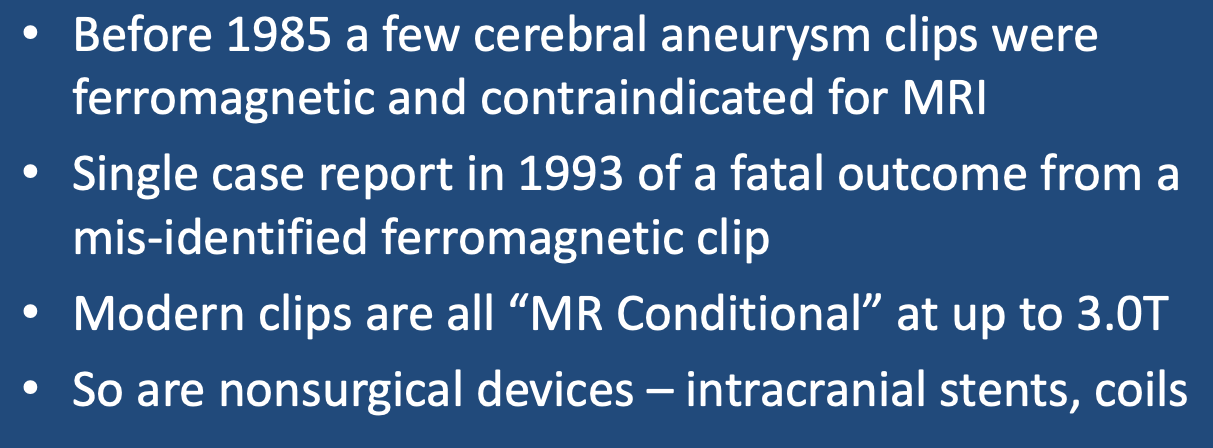The first (and to my knowledge only fatal event) occurring in an MRI patient with a cerebral aneurysm clip occurred in Texas in 1993. The details of this case are worth reviewing, as they provide some lessons for MR safety.
 Fatal intracranial hemorrhage from movement of a ferromagnetic aneurysm clip (From Radiology 1993; 187:855)
Fatal intracranial hemorrhage from movement of a ferromagnetic aneurysm clip (From Radiology 1993; 187:855)
The patient was a 74-year-old woman who was known to have an aneurysm clip implanted 15 years previously at another institution. Not knowing the nature of the clip, the MR Center originally refused to perform the scan. The patient's family directly contacted the neurosurgeon who placed the clip, reporting back that the implant was a "Yasargil clip" (known to be "MR Compatible"). The MRI was scheduled, and as the patient reached a point about 4 feet from the bore of the 1.5T magnet, she complained of a severe headache. She was transferred to the emergency room where a massive intracranial hemorrhage was noted. At autopsy a tear in the arterial wall was found at the site of clip placement with fresh blood. Upon removal and inspection, the clip was found not to be a "Yasargil" but rather a "Codman Sundt-Kees Vari-Angle Clip" known to be highly ferromagnetic and contraindicated for MRI. This was confirmed in the original operative note obtained posthumously from microfilm.
The lesson we all learned from this is that you cannot simply take the word of a patient or family member about the identity of an aneurysm clip (or other implant). You need to see the actual implant card or operative note with specific information (e.g., manufacturer, type/model, lot/serial number) before making a decision about MR safety.
Fortunately, ferromagnetic cerebral aneurysm clips have not been manufactured since the mid-1980s, and thus will rarely be encountered in patients today. All modern aneurysm clips are composed of titanium titanium-alloys, MP35N (nickel/chromium/cobalt), Elgiloy/Phynox (cobalt/nickel/iron) or other non- or at most minimally ferromagnetic properties. Thus virtually any cerebral aneurysm clip implanted in the last 25 years will be MR compatible at least up to 3.0T.
|
|
Today a significant fraction of intracranial aneurysms are treated endovascularly with detachable coils and stents. Their composition is typically platinium, Nitinol, or platinium-irridium. These devices are made by multiple companies and to my knowledge all are MR Conditional at 1.5T and 3.0T with no waiting period required following implantation.
|
Advanced Discussion (show/hide)»
No supplementary material yet. Check back soon!
References
Dujovny M, Agner C, Ide O, Perlin A. Self-closing aneurysm clip: a historical review. Neurol Res 2010; 32:1011-1020. [DOI LINK]
Kangarlu A, Shellock FG. Aneurysm clips: evaluation of magnetic field interactions with an 8.0 T MR system. J Magn Reson Imaging 2000;12:107-111. (not all clips safe at 3.0T may be safe at 8.0T)
Klucznik RP, Carrier DA, Paka, Haid RW. Placement of a ferromagnetic intracerebral aneurysm clip in a magnetic field with a fatal outcome. Radiology 1993;187:855-856.
McFadden JT. Magnetic resonance imaging and aneurysm clips. A review. J Neurosurg 2012; 117; 1-11.
Shellock FG. Valencerina S. In vitro evaluation of MR imaging issues at 3-T for aneurysm clips made from MP35N: Findings and information applied to 155 additional aneurysm clips. Am J Neuroradiol 2010;31:615-619.
Slesnick TC, Schreier J, Soriano BD, et al. Safety of magnetic resonance imaging after implantation of stainless steel embolization coils. Pediatric Cardiol 2016; 37:62-67.
Society for Medical Physics of the Netherlands (NVKF). Guideline use of MRI in patients with implants. Module 2: MRI in patients with cerebral aneurysm clip. English version 2021.
Dujovny M, Agner C, Ide O, Perlin A. Self-closing aneurysm clip: a historical review. Neurol Res 2010; 32:1011-1020. [DOI LINK]
Kangarlu A, Shellock FG. Aneurysm clips: evaluation of magnetic field interactions with an 8.0 T MR system. J Magn Reson Imaging 2000;12:107-111. (not all clips safe at 3.0T may be safe at 8.0T)
Klucznik RP, Carrier DA, Paka, Haid RW. Placement of a ferromagnetic intracerebral aneurysm clip in a magnetic field with a fatal outcome. Radiology 1993;187:855-856.
McFadden JT. Magnetic resonance imaging and aneurysm clips. A review. J Neurosurg 2012; 117; 1-11.
Shellock FG. Valencerina S. In vitro evaluation of MR imaging issues at 3-T for aneurysm clips made from MP35N: Findings and information applied to 155 additional aneurysm clips. Am J Neuroradiol 2010;31:615-619.
Slesnick TC, Schreier J, Soriano BD, et al. Safety of magnetic resonance imaging after implantation of stainless steel embolization coils. Pediatric Cardiol 2016; 37:62-67.
Society for Medical Physics of the Netherlands (NVKF). Guideline use of MRI in patients with implants. Module 2: MRI in patients with cerebral aneurysm clip. English version 2021.
Related Questions
Are all stents and stent grafts safe to scan? Isn't there a waiting period after implantation?
Are all stents and stent grafts safe to scan? Isn't there a waiting period after implantation?

